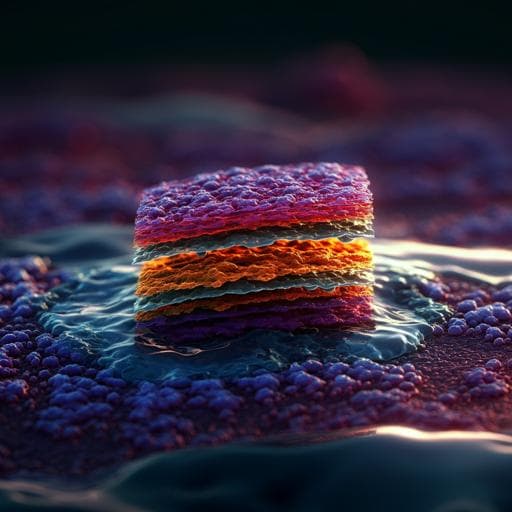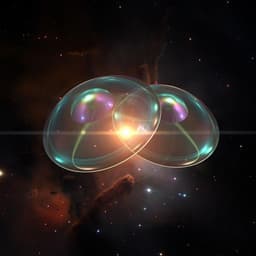
Chemistry
Deciphering in-situ surface reconstruction in two-dimensional CdPS<sub>3</sub> nanosheets for efficient biomass hydrogenation
M. G. Sendeku, K. Harrath, et al.
This groundbreaking study reveals how in-situ surface reconstruction of a CdPS3 nanosheet electrocatalyst can remarkably enhance the hydrogenation of 5-hydroxymethylfurfural to 2,5-bis(hydroxymethyl)furan, achieving a remarkable Faradaic efficiency of 91.3% under ambient conditions. Investigated by an expert team including Marshet Getaye Sendeku and Karim Harrath, this research paves the way for advancements in electrocatalysis.
~3 min • Beginner • English
Introduction
The chemical manufacturing sector accounts for a significant portion of global greenhouse gas emissions and energy use, with fossil fuels dominating the sector’s energy supply. Biomass valorization offers a promising route to reduce emissions by upgrading biomass-derived intermediates such as 5-hydroxymethylfurfural (HMF) into value-added products like 2,5-bis(hydroxymethyl)furan (BHMF). Conventional thermocatalytic HMF hydrogenation relies on precious metals and harsh conditions (high pressure and temperature) and uses H2 gas, posing energy and environmental concerns. Electrocatalytic hydrogenation (ECH) can use water as the hydrogen source under ambient conditions but faces selectivity challenges, including formation of undesired dimer (BHH) at low overpotentials and competing hydrogen evolution reaction (HER) at higher overpotentials. While Ag and Cu-based electrodes can afford reasonable BHMF selectivity, precious metal content and HER competition remain issues. Dynamic surface reconstruction of electrode materials can generate the true active sites, tuning adsorption energies of intermediates. Two-dimensional (2D) metal phosphorus trisulfides (MPS3) are promising due to their sulfur- and phosphorus-rich frameworks that may easily undergo surface reconstruction, exposing active sites to promote selectivity. This study investigates in-situ surface reconstruction of 2D CdPS3 nanosheets to enhance ECH of HMF to BHMF and elucidates the role of electrolyte-triggered reconstruction and heterointerface formation in improving activity and selectivity.
Literature Review
Prior studies demonstrate selective electrocatalytic HMF hydrogenation on Ag and Cu electrodes achieving >85% selectivity for BHMF, though Ag is precious and HER competition persists. Dynamic surface reconstruction is recognized in phosphides, chalcogenides, and oxides as a key factor in creating active species that optimize intermediate adsorption and improve activity. Two-dimensional materials have been used for biomass electro-upgrading, and MPS3 nanosheets have shown activity in HER, OER, CO2 reduction, and N2 reduction, suggesting their versatility and potential for surface transformation. Earlier work indicates CdPS3 has poor HER activity, beneficial for selective HMF hydrogenation. However, the role of in-situ generated heterostructures during ECH and the influence of electrolytes on reconstruction have been less explored. This work builds on these insights by probing in-situ reconstruction of CdPS3 into a CdPS3/CdS heterointerface and its mechanistic impact on HMF hydrogenation.
Methodology
Synthesis: Ultrathin CdPS3 nanosheets (NSs) were synthesized on carbon cloth (CC) via a two-step process: (1) solvothermal synthesis of CdS nanoparticle precursors; (2) space-confined chemical vapor conversion (SCCVC) in a two-zone tube furnace using a P:S (1:3) solid mixture. The front and back zones were heated to ~300 °C and 420 °C, respectively, under Ar flow for 20 min. Growth conditions (420 °C, 20 min) were optimized to obtain ultrathin NSs (~7 nm thick) with preferred orientation.
Characterization: Structure and morphology were analyzed by XRD (Cu Kα), Raman spectroscopy (532 nm), SEM/EDS, TEM/HR-TEM, AFM, and XPS. In-situ Raman spectroscopy used a custom electrochemical cell with CdPS3 ink on glassy carbon, Ag/AgCl reference, and Pt counter. Ex-situ XRD/XPS/TEM were performed on electrodes post-electrolysis to detect reconstruction.
Electrochemical testing: H-type three-electrode glass cell (Nafion 117 separator) with CdPS3/CC working electrode (~1.1 mg cm−2 loading, 1×1 cm2), Ag/AgCl reference, and Pt counter. Potentials referenced to RHE: E(RHE)=E(Ag/AgCl)+0.197+0.0591×pH. Electrolytes: 0.1 M phosphate buffer (PBS, pH 9.2) and 0.1 M borate buffer (BBS, pH 9.2). HMF hydrogenation used 10–20 mM HMF in 0.1 M buffer, chronoamperometry at set potentials, with pre-activation by cyclic voltammetry (CV) cycles as indicated. EIS measured charge transfer resistance. Products were quantified by 1H NMR using D2O/DMSO internal standard and calibration curves.
Performance metrics: Faradaic efficiency (FE) for BHMF was computed from BHMF moles relative to charge passed (2e− per BHMF), and yield rate from concentration, volume, and time. Cycling tests assessed stability over repeated runs with electrolyte refresh.
Paired electrolysis: MnCo2O4 nanorod arrays on Ni foam (MnCo2O4/NF) were synthesized (per Supplementary) and evaluated for glycerol oxidation reaction (GOR) in alkaline media. Paired cell combined CdPS3 cathode (HMF hydrogenation) with MnCo2O4/NF anode (GOR) to co-produce BHMF and formate at set cell voltages.
DFT calculations: Spin-polarized DFT (VASP, PBE functional, PAW, 500 eV cutoff, 3×3×1 k-point mesh) modeled CdPS3(001), CdS(110), and CdPS3(001)/CdS(110) heterostructure slabs with 15 Å vacuum. vdW corrections via Grimme D3 with BJ damping. Transition states located by the Dimer method and confirmed by vibrational analysis. Gibbs free energies included zero-point energy, entropy, potential, and pH corrections (pH=0 in computations). Adsorption free energies for H* (ΔGH) and HMF* (ΔGHMF), water dissociation energetics, and reaction pathways (Langmuir–Hinshelwood and Eley–Rideal; O- vs C-pathways) were computed.
Key Findings
- In-situ surface reconstruction: In 0.1 M PBS, in-situ Raman revealed emergence of a ~301 cm−1 peak (CdS LO mode) at potentials negative of HMF reduction onset (e.g., −0.5 to −0.7 V_RHE), indicating formation of CdS on CdPS3 during electrolysis. No CdS signal was observed in 0.1 M BBS across potentials, highlighting electrolyte dependence.
- Structural confirmation: Ex-situ XRD of spent electrodes showed a new peak at 31.8° indexed to cubic CdS (110). XPS Cd 3d5/2 exhibited negative shifts after electrolysis: 405.35 eV (−0.55 V_RHE), 405.21 eV (−0.7 V_RHE), 405.05 eV (−1.0 V_RHE) compared to pristine CdPS3 (405.8 eV) and CdS (404.85 eV), evidencing CdS formation. HR-TEM showed a 5–7 nm reconstructed surface layer with 0.34 nm lattice fringes indexed to CdS (001), forming a CdPS3/CdS heterostructure without major morphology change by SEM.
- Electrocatalytic performance: CdPS3 nanosheets achieved BHMF Faradaic efficiency (FE) up to 91.3 ± 2.3% and yield 4.96 ± 0.16 mg h−1 at −0.7 V_RHE (10 mM HMF, 0.1 M PBS). BHMF production rate increased from 0.63 ± 0.12 to 4.96 ± 0.16 mg h−1 when potential shifted from −0.55 to −0.7 V_RHE, then decreased at −0.75 V_RHE due to HER onset. In BBS, FE for BHMF was 59.3% at −0.7 V_RHE, indicating PBS promotes reconstruction and selectivity. Pure carbon cloth showed negligible activity.
- Activation and stability: Electrodes pre-activated by CV cycles in PBS with HMF showed improved activity. The CdPS3_25 electrode maintained similar FE and yield over seven cycles at −0.7 V_RHE. Charge-dependent tests reached BHMF 7.6 mM and retained HMF 1.56 mM after 60 C. EIS showed lower R_ct with HMF present (∼9.45 Ω) than without (∼15 Ω), indicating facilitated charge transfer.
- Controls: Pristine CdS on CC yielded max FE 44.8% (−0.65 V_RHE) with lower rates than in-situ heterostructure. Ex-situ fabricated CdPS3/CdS_QD gave FE 75.9% at −0.7 V_RHE, still below in-situ. Other 2D materials (In2S3, CdPSe3) showed no surface reconstruction or performance change upon activation.
- Mechanistic insights (DFT and electrochemistry): On CdPS3(001)/CdS(110) heterointerface, ΔGH at S interface site is 0.53 eV (favorable for H* adsorption), while CdPS3 alone exhibits high ΔGH (1.95 eV at P, 1.40 eV at S) and CdS(110) has ΔGH 0.74 eV at S and 1.73 eV at Cd. Water dissociation to H* is exothermic on the heterostructure (ΔG = −0.49 eV) vs CdS (−0.31 eV) and endergonic on CdPS3 (+0.66 eV). HMF adsorption is strongest on Cd sites at the heterointerface (ΔGHMF = −0.94 eV) vs CdPS3 (−0.28 eV) and CdS (−0.62 eV). The LH O-pathway has lower barriers on the heterointerface: first H transfer ΔG = 0.29 eV and second H transfer ΔG = 0.20 eV, compared to CdS (0.67 and 0.82 eV). CV with increasing HMF concentration suppressed H+ desorption peaks, consistent with LH mechanism and consumption of surface H* by adsorbed HMF.
- Paired electrosynthesis: MnCo2O4/NF anode achieved FE for formate up to 90.6% at 1.6 V_RHE during glycerol oxidation. In a two-electrode cell pairing CdPS3 cathode (HMF hydrogenation) with MnCo2O4/NF anode (GOR), FE_BHMF = 67.7% and FE_formate = 75.25% at 1.9 V cell voltage were obtained (noting lower FEs than separate half-reactions).
Discussion
The study addresses the challenge of achieving high selectivity and activity for electrocatalytic HMF hydrogenation while mitigating HER by exploiting in-situ surface reconstruction of CdPS3 in PBS to form a CdPS3/CdS heterointerface. Operando Raman, ex-situ XRD/XPS/TEM unequivocally confirm the electrolyte-triggered generation of a thin CdS layer bound to CdPS3. This heterointerface optimizes the adsorption landscape by localizing HMF adsorption on interfacial Cd sites and H* adsorption on adjacent S sites, thereby facilitating the Langmuir–Hinshelwood O-pathway with significantly reduced energy barriers for sequential hydrogenation steps. The weaker HER propensity at mild potentials further enhances BHMF selectivity. The electrolyte dependence (PBS vs BBS) underscores the role of phosphate buffer in initiating reconstruction, which correlates with the higher FE observed in PBS. The ability to pair the optimized cathode with a glycerol oxidation anode to co-produce BHMF and formate demonstrates broader applicability toward energy-efficient, value-added paired electrosynthesis.
Conclusion
This work introduces a space-confined chemical vapor conversion route to grow ultrathin CdPS3 nanosheets that undergo electrolyte-triggered in-situ surface reconstruction to form an active CdPS3/CdS heterointerface. The catalyst achieves high BHMF selectivity and productivity (FE 91.3 ± 2.3%, 4.96 ± 0.16 mg h−1 at −0.7 V_RHE) due to optimized adsorption and lowered kinetic barriers at the heterointerface, as supported by operando and ex-situ characterizations and DFT. The LH O-pathway is favored, with interfacial Cd and S sites synergistically activating HMF and H*, respectively. In a paired configuration with MnCo2O4/NF for glycerol oxidation, concurrent synthesis of BHMF and formate is realized at low cell voltages. The insights into electrolyte-driven surface reconstruction and structure–activity relationships provide a foundation for designing other P- and S-rich 2D electrocatalysts. Future work could focus on optimizing anodic oxidation reactions to improve overall paired efficiencies and exploring electrolyte effects and heterointerface engineering across related chalcogenide/phosphide systems.
Limitations
- The in-situ surface reconstruction and enhanced selectivity are strongly electrolyte-dependent: PBS promotes CdS formation and high FE, whereas BBS does not induce reconstruction and yields lower FE.
- In paired electrolysis, the Faradaic efficiencies for BHMF and formate are reduced compared to the separate half-reactions, indicating room for improvement via alternative or optimized anodic reactions and system integration.
- The study focuses on specific operating conditions (pH 9.2, buffer types, potentials); broader stability and scalability assessments under varied electrolytes and long-term operation are not detailed.
Related Publications
Explore these studies to deepen your understanding of the subject.







